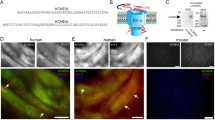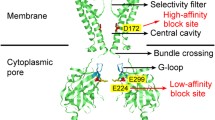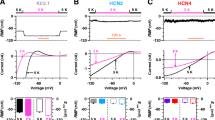Abstract
The inward rectifier K+ channel Kir2.1 contributes to the maintenance of the resting cell membrane potential in excitable cells. Loss of function mutations of KCNJ2 encoding Kir2.1 result in Andersen-Tawil syndrome, a disorder characterized by periodic paralysis, cardiac arrhythmia, and dysmorphic features. The ubiquitously expressed protein kinase B (PKB/Akt) activates the phosphatidylinositol-3-phosphate-5-kinase PIKfyve, which in turn regulates a variety of carriers and channels. The present study explored whether PKB/PIKfve contributes to the regulation of Kir2.1. To this end, cRNA encoding Kir2.1 was injected into Xenopus oocytes with and without additional injection of cRNA encoding wild type PKB (PKB), constitutively active T308D,S473DPKB or inactive T308A,S473APKB. Kir2.1 activity was determined by two-electrode voltage-clamp. As a result, PKB and T308D,S473DPKB, but not T308A,S473APKB, significantly increased Kir2.1-mediated currents. The effect of PKB was mimicked by coexpression of PIKfyve but not of S318APikfyve lacking the PKB phosphorylation site. The decay of Kir2.1-mediated currents after inhibition of channel insertion into the cell membrane by brefeldin A (5 μM) was similar in oocytes expressing Kir2.1 + PKB or Kir2.1 + PIKfyve to those expressing Kir2.1 alone, suggesting that PKB and PIKfyve influence channel insertion into rather than channel retrieval from the cell membrane. In conclusion, PKB and PIKfyve are novel regulators of Kir2.1.




Similar content being viewed by others
Reference
Alesutan IS, Ureche ON, Laufer J, Klaus F, Zürn A, Lindner R, Strutz-Seebohm N, Tavaré JM, Boehmer C, Palmada M, Lang UE, Seebohm G, Lang F (2010) Regulation of the glutamate transporter EAAT4 by PIKfyve. Cell Physiol Biochem 25:187–194
Andersen ED, Krasilnikoff PA, Overvad H (1971) Intermittent muscular weakness, extrasystoles, and multiple developmental anomalies. A new syndrome? Acta Paediatr Scand 60:559–564
Becker S, Reinehr R, Graf D, vom Dahl S, Häussinger D (2007) Hydrophobic bile salts induce hepatocyte shrinkage via NADPH oxidase activation. Cell Physiol Biochem 19:89–98
Berwick DC, Dell GC, Welsh GI, Heesom KJ, Hers I, Fletcher LM, Cooke FT, Tavaré JM (2004) Protein kinase B phosphorylation of PIKfyve regulates the trafficking of GLUT4 vesicles. J Cell Sci 117:5985–5993
Bhandaru M, Kempe DS, Rotte A, Capuano P, Pathare G, Sopjani M, Alesutan I, Tyan L, Huang DY, Siraskar B, Judenhofer MS, Stange G, Pichler BJ, Biber J, Quintanilla-Martinez L, Wagner CA, Pearce D, Föller M, Lang F (2011) Decreased bone density and increased phosphaturia in gene-targeted mice lacking functional serum- and glucocorticoid-inducible kinase 3. Kidney Int 80:61–67
Boehmer C, Rajamanickam J, Schniepp R, Kohler K, Wulff P, Kuhl D, Palmada M, Lang F (2005) Regulation of the excitatory amino acid transporter EAAT5 by the serum and glucocorticoid dependent kinases SGK1 and SGK3. Biochem Biophys Res Commun 329:738–742
Boehmer C, Palmada M, Rajamanickam J, Schniepp R, Amara S, Lang F (2006) Post-translational regulation of EAAT2 function by co-expressed ubiquitin ligase Nedd4-2 is impacted by SGK kinases. J Neurochem 97:911–921
Böhmer C, Sopjani M, Klaus F, Lindner R, Laufer J, Jeyaraj S, Lang F, Palmada M (2010) The serum and glucocorticoid inducible kinases SGK1-3 stimulate the neutral amino acid transporter SLC6A19. Cell Physiol Biochem 25:723–732
Boiteux A, Hess B (1981) Design of glycolysis. Philos Trans R Soc Lond B Biol Sci 293:5–22
Bortner CD, Cidlowski JA (2004) The role of apoptotic volume decrease and ionic homeostasis in the activation and repression of apoptosis. Pflugers Arch 448:313–318
Bravo R, Otero C, Allende CC, Allende JE (1978) Amphibian oocyte maturation and protein synthesis: related inhibition by cyclic AMP, theophylline, and papaverine. Proc Natl Acad Sci USA 75:1242–1246
Collins A, Larson M (2002) Differential sensitivity of inward rectifier K+ channels to metabolic inhibitors. J Biol Chem 277:35815–35818
Dart C, Leyland ML (2001) Targeting of an A kinase-anchoring protein, AKAP79, to an inwardly rectifying potassium channel, Kir2.1. J Biol Chem 276:20499–20505
de Lartigue J, Polson H, Feldman M, Shokat K, Tooze SA, Urbé S, Clague MJ (2009) PIKfyve regulation of endosome-linked pathways. Traffic 10:883–893
Dërmaku-Sopjani M, Sopjani M, Saxena A, Shojaiefard M, Bogatikov E, Alesutan I, Eichenmüller M, Lang F (2011) Downregulation of NaPi-IIa and NaPi-IIb Na-coupled phosphate transporters by coexpression of Klotho. Cell Physiol Biochem 28:251–258
Diaz RJ, Zobel C, Cho HC, Batthish M, Hinek A, Backx PH, Wilson GJ (2004) Selective inhibition of inward rectifier K+ channels (Kir2.1 or Kir2.2) abolishes protection by ischemic preconditioning in rabbit ventricular cardiomyocytes. Circ Res 95:325–332
Dieter M, Palmada M, Rajamanickam J, Aydin A, Busjahn A, Boehmer C, Luft FC, Lang F (2004) Regulation of glucose transporter SGLT1 by ubiquitin ligase Nedd4-2 and kinases SGK1, SGK3, and PKB. Obes Res 12:862–870
Donaldson MR, Jensen JL, Tristani-Firouzi M, Tawil R, Bendahhou S, Suarez WA, Cobo AM, Poza JJ, Behr E, Wagstaff J, Szepetowski P, Pereira S, Mozaffar T, Escolar DM, Fu YH, Ptácek LJ (2003) PIP2 binding residues of Kir2.1 are common targets of mutations causing Andersen syndrome. Neurology 60:1811–1816
Eckey K, Strutz-Seebohm N, Katz G, Fuhrmann G, Henrion U, Pott L, Linke WA, Arad M, Lang F, Seebohm G (2010) Modulation of human ether a gogo related channels by CASQ2 contributes to etiology of catecholaminergic polymorphic ventricular tachycardia (CPVT). Cell Physiol Biochem 26:503–512
Föller M, Kasinathan RS, Duranton C, Wieder T, Huber SM, Lang F (2006) PGE2-induced apoptotic cell death in K562 human leukaemia cells. Cell Physiol Biochem 17:201–210
Gehring EM, Lam RS, Siraskar G, Koutsouki E, Seebohm G, Ureche ON, Ureche L, Baltaev R, Tavare JM, Lang F (2009a) PIKfyve upregulates CFTR activity. Biochem Biophys Res Commun 390:952–957
Gehring EM, Zurn A, Klaus F, Laufer J, Sopjani M, Lindner R, Strutz-Seebohm N, Tavaré JM, Boehmer C, Palmada M, Lang UE, Seebohm G, Lang F (2009b) Regulation of the glutamate transporter EAAT2 by PIKfyve. Cell Physiol Biochem 24:361–368
Henry P, Pearson WL, Nichols CG (1996) Protein kinase C inhibition of cloned inward rectifier (HRK1/KIR2.3) K+ channels expressed in Xenopus oocytes. J Physiol 495(pt 3):681–688
Hibino H, Inanobe A, Furutani K, Murakami S, Findlay I, Kurachi Y (2010) Inwardly rectifying potassium channels: their structure, function, and physiological roles. Physiol Rev 90:291–366
Hill EV, Hudson CA, Vertommen D, Rider MH, Tavaré JM (2010) Regulation of PIKfyve phosphorylation by insulin and osmotic stress. Biochem Biophys Res Commun 397:650–655
Hosseinzadeh Z, Bhavsar SK, Sopjani M, Alesutan I, Saxena A, Dërmaku-Sopjani M, Lang F (2011) Regulation of the glutamate transporters by JAK2. Cell Physiol Biochem 28:693–702
Ikonomov OC, Sbrissa D, Shisheva A (2001) Mammalian cell morphology and endocytic membrane homeostasis require enzymatically active phosphoinositide 5-kinase PIKfyve. J Biol Chem 276:26141–26147
Ikonomov OC, Sbrissa D, Mlak K, Kanzaki M, Pessin J, Shisheva A (2002) Functional dissection of lipid and protein kinase signals of PIKfyve reveals the role of PtdIns 3,5–P2 production for endomembrane integrity. J Biol Chem 277:9206–9211
Ikonomov OC, Sbrissa D, Foti M, Carpentier JL, Shisheva A (2003) PIKfyve controls fluid phase endocytosis but not recycling/degradation of endocytosed receptors or sorting of procathepsin D by regulating multivesicular body morphogenesis. Mol Biol Cell 14:4581–4591
Ikonomov OC, Sbrissa D, Shisheva A (2006) Localized PtdIns 3,5–P2 synthesis to regulate early endosome dynamics and fusion. Am J Physiol Cell Physiol 291:C393–C404
Ikonomov OC, Sbrissa D, Fenner H, Shisheva A (2009) PIKfyve-ArPIKfyve-Sac3 core complex: contact sites and their consequence for Sac3 phosphatase activity and endocytic membrane homeostasis. J Biol Chem 284:35794–35806
Jones SV (2003) Role of the small GTPase Rho in modulation of the inwardly rectifying potassium channel Kir2.1. Mol Pharmacol 64:987–993
Kirkbride KC, Hong NH, French CL, Clark ES, Jerome WG, Weaver AM (2012) Regulation of late endosomal/lysosomal maturation and trafficking by cortactin affects Golgi morphology. Cytoskeleton (Hoboken) 69:625–643
Klaus F, Palmada M, Lindner R, Laufer J, Jeyaraj S, Lang F, Boehmer C (2008) Up-regulation of hypertonicity-activated myo-inositol transporter SMIT1 by the cell volume-sensitive protein kinase SGK1. J Physiol 586:1539–1547
Klaus F, Laufer J, Czarkowski K, Strutz-Seebohm N, Seebohm G, Lang F (2009) PIKfyve-dependent regulation of the Cl− channel ClC-2. Biochem Biophys Res Commun 381:407–411
Klausner RD, Donaldson JG, Lippincott-Schwartz J (1992) Brefeldin A: insights into the control of membrane traffic and organelle structure. J Cell Biol 116:1071–1080
Lang F, Rehwald W (1992) Potassium channels in renal epithelial transport regulation. Physiol Rev 72:1–32
Lang F, Messner G, Rehwald W (1986) Electrophysiology of sodium-coupled transport in proximal renal tubules. Am J Physiol 250:F953–F962
Lang F, Busch GL, Ritter M, Völkl H, Waldegger S, Gulbins E, Häussinger D (1998) Functional significance of cell volume regulatory mechanisms. Physiol Rev 78:247–306
Leonoudakis D, Conti LR, Radeke CM, McGuire LM, Vandenberg CA (2004) A multiprotein trafficking complex composed of SAP97, CASK, Veli, and Mint1 is associated with inward rectifier Kir2 potassium channels. J Biol Chem 279:19051–19063
Leyland ML, Dart C (2004) An alternatively spliced isoform of PSD-93/chapsyn 110 binds to the inwardly rectifying potassium channel, Kir2.1. J Biol Chem 279:43427–43436
Liu GX, Derst C, Schlichthörl G, Heinen S, Seebohm G, Brüggemann A, Kummer W, Veh RW, Daut J, Preisig-Müller R (2001a) Comparison of cloned Kir2 channels with native inward rectifier K+ channels from guinea-pig cardiomyocytes. J Physiol 532:115–126
Liu Y, Liu D, Heath L, Meyers DM, Krafte DS, Wagoner PK, Silvia CP, Yu W, Curran ME (2001b) Direct activation of an inwardly rectifying potassium channel by arachidonic acid. Mol Pharmacol 59:1061–1068
Lodge NJ, Normandin DE (1997) Alterations in Ito1, IKr and Ik1 density in the BIO TO-2 strain of syrian myopathic hamsters. J Mol Cell Cardiol 29:3211–3221
Lopatin AN, Nichols CG (2001) Inward rectifiers in the heart: an update on I(K1). J Mol Cell Cardiol 33:625–638
Lupescu A, Geiger C, Zahir N, Aberle S, Lang PA, Kramer S, Wesselborg S, Kandolf R, Foller M, Lang F, Bock CT (2009) Inhibition of Na+/H+ exchanger activity by parvovirus B19 protein NS1. Cell Physiol Biochem 23:211–220
Mohamed MR, Alesutan I, Föller M, Sopjani M, Bress A, Baur M, Salama RH, Bakr MS, Mohamed MA, Blin N, Lang F, Pfister M (2010) Functional analysis of a novel I71 N mutation in the GJB2 gene among Southern Egyptians causing autosomal recessive hearing loss. Cell Physiol Biochem 26:959–966
Morris AJ, Smyth SS (2007) Measurement of autotaxin/lysophospholipase D activity. Methods Enzymol 434:89–104
Nehring RB, Wischmeyer E, Döring F, Veh RW, Sheng M, Karschin A (2000) Neuronal inwardly rectifying K(+) channels differentially couple to PDZ proteins of the PSD-95/SAP90 family. J Neurosci 20:156–162
O’Connor CM, Smith LD (1976) Inhibition of oocyte maturation by theophylline: possible mechanism of action. Dev Biol 52:318–322
Palmada M, Speil A, Jeyaraj S, Böhmer C, Lang F (2005) The serine/threonine kinases SGK1, 3 and PKB stimulate the amino acid transporter ASCT2. Biochem Biophys Res Commun 331:272–277
Plaster NM, Tawil R, Tristani-Firouzi M, Canún S, Bendahhou S, Tsunoda A, Donaldson MR, Iannaccone ST, Brunt E, Barohn R, Clark J, Deymeer F, George AL Jr, Fish FA, Hahn A, Nitu A, Ozdemir C, Serdaroglu P, Subramony SH, Wolfe G, Fu YH, Ptácek LJ (2001) Mutations in Kir2.1 cause the developmental and episodic electrical phenotypes of Andersen’s syndrome. Cell 105:511–519
Preisig-Müller R, Schlichthörl G, Goerge T, Heinen S, Brüggemann A, Rajan S, Derst C, Veh RW, Daut J (2002) Heteromerization of Kir2.x potassium channels contributes to the phenotype of Andersen’s syndrome. Proc Natl Acad Sci USA 99:7774–7779
Rexhepaj R, Dërmaku-Sopjani M, Gehring EM, Sopjani M, Kempe DS, Föller M, Lang F (2010) Stimulation of electrogenic glucose transport by glycogen synthase kinase 3. Cell Physiol Biochem 26:641–646
Rohács T, Chen J, Prestwich GD, Logothetis DE (1999) Distinct specificities of inwardly rectifying K(+) channels for phosphoinositides. J Biol Chem 274:36065–36072
Romanenko VG, Fang Y, Byfield F, Travis AJ, Vandenberg CA, Rothblat GH, Levitan I (2004) Cholesterol sensitivity and lipid raft targeting of Kir2.1 channels. Biophys J 87:3850–3861
Rusten TE, Rodahl LM, Pattni K, Englund C, Samakovlis C, Dove S, Brech A, Stenmark H (2006) Fab1 phosphatidylinositol 3-phosphate 5-kinase controls trafficking but not silencing of endocytosed receptors. Mol Biol Cell 17:3989–4001
Rutherford AC, Traer C, Wassmer T, Pattni K, Bujny MV, Carlton JG, Stenmark H, Cullen PJ (2006) The mammalian phosphatidylinositol 3-phosphate 5-kinase (PIKfyve) regulates endosome-to-TGN retrograde transport. J Cell Sci 119:3944–3957
Sampson LJ, Leyland ML, Dart C (2003) Direct interaction between the actin-binding protein filamin-A and the inwardly rectifying potassium channel, Kir2.1. J Biol Chem 278:41988–41997
Sansone V, Griggs RC, Meola G, Ptácek LJ, Barohn R, Iannaccone S, Bryan W, Baker N, Janas SJ, Scott W, Ririe D, Tawil R (1997) Andersen’s syndrome: a distinct periodic paralysis. Ann Neurol 42:305–312
Sbrissa D, Ikonomov OC, Shisheva A (1999) PIKfyve, a mammalian ortholog of yeast Fab1p lipid kinase, synthesizes 5-phosphoinositides. Effect of insulin. J Biol Chem 274:21589–21597
Sbrissa D, Ikonomov OC, Deeb R, Shisheva A (2002) Phosphatidylinositol 5-phosphate biosynthesis is linked to PIKfyve and is involved in osmotic response pathway in mammalian cells. J Biol Chem 277:47276–47284
Sbrissa D, Ikonomov OC, Strakova J, Shisheva A (2004) Role for a novel signaling intermediate, phosphatidylinositol 5-phosphate, in insulin-regulated F-actin stress fiber breakdown and GLUT4 translocation. Endocrinology 145:4853–4865
Schneider J, Nicolay JP, Foller M, Wieder T, Lang F (2007) Suicidal erythrocyte death following cellular K+ loss. Cell Physiol Biochem 20:35–44
Seebohm G, Strutz-Seebohm N, Birkin R, Dell G, Bucci C, Spinosa MR, Baltaev R, Mack AF, Korniychuk G, Choudhury A, Marks D, Pagano RE, Attali B, Pfeufer A, Kass RS, Sanguinetti MC, Tavare JM, Lang F (2007) Regulation of endocytic recycling of KCNQ1/KCNE1 potassium channels. Circ Res 100:686–692
Shimizu T, Wehner F, Okada Y (2006) Inhibition of hypertonicity-induced cation channels sensitizes HeLa cells to shrinkage-induced apoptosis. Cell Physiol Biochem 18:295–302
Shojaiefard M, Christie DL, Lang F (2005) Stimulation of the creatine transporter SLC6A8 by the protein kinases SGK1 and SGK3. Biochem Biophys Res Commun 334:742–746
Shojaiefard M, Strutz-Seebohm N, Tavaré JM, Seebohm G, Lang F (2007) Regulation of the Na(+), glucose cotransporter by PIKfyve and the serum and glucocorticoid inducible kinase SGK1. Biochem Biophys Res Commun 359:843–847
Soom M, Schönherr R, Kubo Y, Kirsch C, Klinger R, Heinemann SH (2001) Multiple PIP2 binding sites in Kir2.1 inwardly rectifying potassium channels. FEBS Lett 490:49–53
Sopjani M, Kunert A, Czarkowski K, Klaus F, Laufer J, Föller M, Lang F (2010) Regulation of the Ca(2+) channel TRPV6 by the kinases SGK1, PKB/Akt, and PIKfyve. J Membr Biol 233:35–41
Strutz-Seebohm N, Shojaiefard M, Christie D, Tavare J, Seebohm G, Lang F (2007) PIKfyve in the SGK1 mediated regulation of the creatine transporter SLC6A8. Cell Physiol Biochem 20:729–734
Strutz-Seebohm N, Pusch M, Wolf S, Stoll R, Tapken D, Gerwert K, Attali B, Seebohm G (2011) Structural basis of slow activation gating in the cardiac I Ks channel complex. Cell Physiol Biochem 27:443–452
Tawil R, Ptacek LJ, Pavlakis SG, DeVivo DC, Penn AS, Ozdemir C, Griggs RC (1994) Andersen’s syndrome: potassium-sensitive periodic paralysis, ventricular ectopy, and dysmorphic features. Ann Neurol 35:326–330
Tristani-Firouzi M, Etheridge SP (2010) Kir 2.1 channelopathies: the Andersen-Tawil syndrome. Pflugers Arch 460:289–294
Tsuruta F, Green EM, Rousset M, Dolmetsch RE (2009) PIKfyve regulates CaV1.2 degradation and prevents excitotoxic cell death. J Cell Biol 187:279–294
Ureche ON, Baltaev R, Ureche L, Strutz-Seebohm N, Lang F, Seebohm G (2008) Novel insights into the structural basis of pH-sensitivity in inward rectifier K+ channels Kir2.3. Cell Physiol Biochem 21:347–356
Vicente R, Coma M, Busquets S, Moore-Carrasco R, López-Soriano FJ, Argilés JM, Felipe A (2004) The systemic inflammatory response is involved in the regulation of K(+) channel expression in brain via TNF-alpha-dependent and -independent pathways. FEBS Lett 572:189–194
Watson RT, Pessin JE (2006) Bridging the GAP between insulin signaling and GLUT4 translocation. Trends Biochem Sci 31:215–222
Welsh GI, Hers I, Berwick DC, Dell G, Wherlock M, Birkin R, Leney S, Tavaré JM (2005) Role of protein kinase B in insulin-regulated glucose uptake. Biochem Soc Trans 33:346–349
Wischmeyer E, Doring F, Karschin A (1998) Acute suppression of inwardly rectifying Kir2.1 channels by direct tyrosine kinase phosphorylation. J Biol Chem 273:34063–34068
Xia M, Jin Q, Bendahhou S, He Y, Larroque MM, Chen Y, Zhou Q, Yang Y, Liu Y, Liu B, Zhu Q, Zhou Y, Lin J, Liang B, Li L, Dong X, Pan Z, Wang R, Wan H, Qiu W, Xu W, Eurlings P, Barhanin J, Chen Y (2005) A Kir2.1 gain-of-function mutation underlies familial atrial fibrillation. Biochem Biophys Res Commun 332:1012–1019
Xiao J, Zhen XG, Yang J (2003) Localization of PIP2 activation gate in inward rectifier K+ channels. Nat Neurosci 6:811–818
Zheng Q, Bobich JA (2004) ADP-ribosylation factor6 regulates both [3H]-noradrenaline and [14C]-glutamate exocytosis through phosphatidylinositol 4,5-bisphosphate. Neurochem Int 45:633–640
Zitron E, Kiesecker C, Lück S, Kathöfer S, Thomas D, Kreye VA, Kiehn J, Katus HA, Schoels W, Karle CA (2004) Human cardiac inwardly rectifying current IKir2.2 is upregulated by activation of protein kinase A. Cardiovasc Res 63:520–527
Acknowledgments
The authors acknowledge the technical assistance of E. Faber. The article was meticulously prepared by S. Rübe. This study was supported by the Deutsche Forschungsgemeinschaft (GK 1302).
Author information
Authors and Affiliations
Corresponding author
Rights and permissions
About this article
Cite this article
Munoz, C., Almilaji, A., Setiawan, I. et al. Up-Regulation of the Inwardly Rectifying K+ Channel Kir2.1 (KCNJ2) by Protein Kinase B (PKB/Akt) and PIKfyve. J Membrane Biol 246, 189–197 (2013). https://doi.org/10.1007/s00232-012-9520-9
Received:
Accepted:
Published:
Issue Date:
DOI: https://doi.org/10.1007/s00232-012-9520-9




